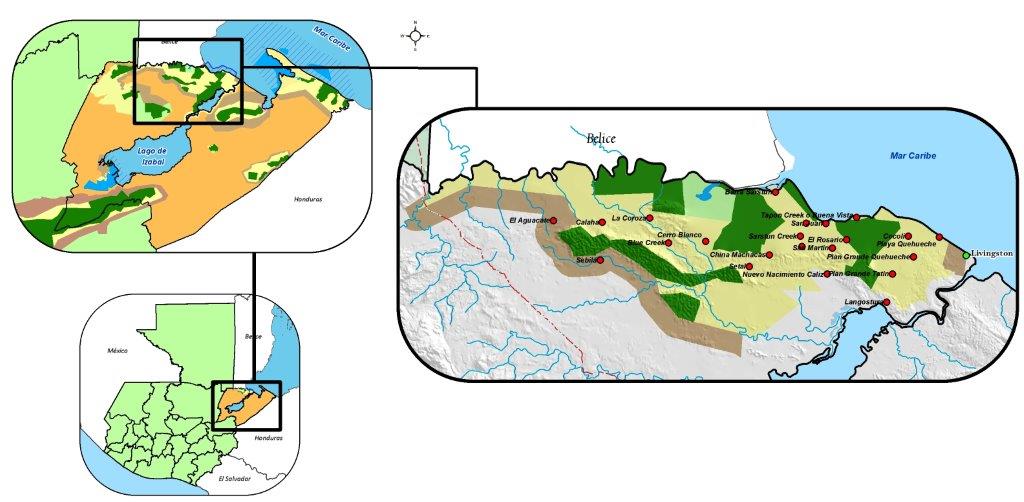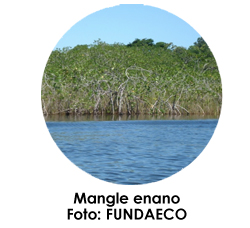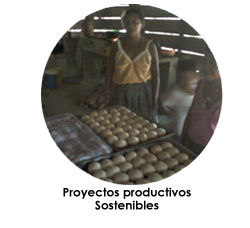Río Sarstún Multiple Use Area

Data Sheet
- Name: Río Sarstún Multiple Use Area
- Management entity: CONAP. In the field, the Consortium Peasant Indigenous Association Amantes de la Tierra/ FUNDAECO support CONAP in the Joint Management
- Location of the Administrative Headquarters: Barrio Playa Barique, Livingsston, Izabal
- Surface: 47,582.12 hectares
- Location: Livingston, Izabal in the border with Belice
- Legal Status: declared by Decree 12-2005 “Law of Declaratory of Río Sarstún Multiple Use Area”
- Creation Date: 2005
- Staff: 1 Manager, 1 Agroforestry Technician, 1 Social and Gender Participation Technician, 1 Environmental Education Technician, 1 Administrative Assistant
- No. of communities inside the area: 22 communities (18 indigenous communities and 4 mixed communities)
- Key Characteristic:
- Río Sarstún is one of the last wild rivers
- Río Sarstún and National Park Sarstoon Temash in Belice, form a binational protected area
- Río Sarstun is a RAMSAR wetland of global relevance
Characteristic
Río Sarstún Multiple Use Area (AUMRS, by its initials in Spanish) is integrated by a biological corridor that covers from the Wild Life Refuge Bocas del Polochic, the Special Protection Area Sierra Santa Cruz, Río Dulce National Park, Chocón Machacas Biotope, Manatees Protected Reserve Cerro San Gil, up to the Wild Life Refuge Punta de Manabique, giving a shelter, growing and reproduction site for fauna and flora of the place and developing at the same time a symbiotic activity with the marine and coast ecological systems.
Río Sarstún Special Value
- It is an ecotone between lagoons, wetlands and tropical forest
- There can be found 30 bat species, being the second site at a species level in Latin America
- It is the habitat for species highly threatened as the manatee, the tapir and the jaguar
- It is an integral part of the migratory bird corridor from the Caribbean, and also a key site in winter
- 56 fish species

The Sarstún system is an important river and estuary system due to its low high that is cyclically affected by tides and continental overflows, allowing mangroves development in the East part of its basin. Río Sarstún is the most important body of water of the reserve; the river flows from West to East and flows into Amatique Bay, has a length of 55km and has 8 tributary rivers Nimblajá, Warre Creek, Quebrada Calajá, Cotón, La Coroza, Ponciano Creek y Paguara Creek (which flow through Laguna Grande) and Lagunita.
This type of wetland is an interrelated ecosystem complex, such as lagoons, mangroves, rivers, statuaries and flooded forest that on this case is of natural origin and is characterized by presenting biological community related to their environment that result in the origin of a highly productive region, such is the case of mangroves that have in their roots sediments that generate benefits that other individuals can use allowing the protection, spawning and growing of fish species. From these fish species stand out the families Cichlidae, Gerridae, Scianidae and crustaceans of commercial value, habitats of ecological niches that facilitate the reproduction of flora species among which it is worth to mention the red mangrove (Hirtella paniculata), Santa María (C. brasiliense) y virola (V. koschnii) guiscoyol (Bactris trichophylla), bayal (Desmoncus ferox) and corozo (Orbygnia cohune) that have been identified in the commercial importance area in addition to be innkeepers for nesting and raising of more than 150 bird species (17 orders and 42 families).
There exist patches of marine pasture; located to the south of the mouth of Río Sarstún (the mouth is too deep to have those pastures).
Historically communities are established in that region and from a social point of view, the wetland has a value as a source of food and work. Together with that factor, the scenic beauty of the area, is a peculiarity that makes it favorable for ecotourism of the area, creating a source of economic income for the communities that are established there, due to the touristic activity, the communities have had the opportunity to be a part of the conservation of natural resources that provides them with alternatives to make productive activities and the conservation of natural resources.
Flora

The vegetation in the area is represented by 130 species distributed in 52 families that include trees of tropical forest as well as wetlands, among them: Callophyllum brasiliense, Vochysia hondurensis, Andi rainermis, Platymiscium dimorphandrum (“Hormigo”), Bombax ellipticum, Dalbergia tucurensis, Virola koschnii, Pouteria amygdalina, Sweetia panamensis, Chrysobalanus icaco, Hirtella paniculata, and Terminalia Amazonia.
In the area there can be found 4 mangrove species: Avicennia germinans, Laguncularia racemosa, Rheizophora mangle and Conocarpus erectus, the last two included in the red list of threatened species from CONAP. One of the most important plant community is the dwarf mangrove. These are unique in the country and are found only in areas where karstic soil come together and part of the threatened species from CONAP.
In the aquatic environment, there are found the marine grasses as Thalassia testudinun and Syringodium filiforme. These grasses are vital because they provide food to many fish species, as the manatee, which is protected by the CITES appendix 1 and is found on the red list from CONAP.
Fauna
56 fish species are registered, represented by 21 families, highlighting 3 commercial value species that in addition are found in the red list form CONAP: Cichlasoma aureum, Astyanax fasciatus and Megalopus atlanticu. There are also found 38 benthic species, belonging to different phyla: Echinodermata, Pori fera, Cnidaria, Crustacea, among others.
Se reportan 56 especies de peces representadas por 21 familias, destacan 3 especies de valor comercial que además se encuentran en la lista roja de CONAP Cichlasoma aureum, Astyanax fasciatus y Megalopus atlanticu; se encuentran tambien 38 especies bentónicas pertenecientes a diferentes phyla: Echinodermata, Pori fera, Cnidaria, Crustacea entre otros.
148 bird species have been reported, belonging to 16 orders and 48 families.
CULTURAL VALUES
In Río Sarstún live two ethnicities that contribute to the cultural richness of the area; Ladinos and Q’eqch I’. A great percentage of the population of these groups live from the natural resources of the region whether for self-consumption or for commercialization. Many local communities live from agriculture, fishing, use of forestall resources, from which there are highlighted wood, firewood, coal, mangrove and the extraction of flora ornamental species.
Q’eqchis communities inside Río Sarstún have a strong relationship with the land and nature, and that is the reason why in the area there are found 16 Sacred Sites, in where they offer ceremonies to thank the spirits of the mountain or to ask for blessings for crops and harvest. Q’eqchi ceremonies are developed during night (xyo’lenk il) in Sacred Sites and finish in the crop land (xchapb’al li k ’al).
In addition to the Q’eqchi Sacred Sites there also exist inside the area 9 Sacred Sites that Garifuna communities use to keep their culture alive, including their music, dance, meditation rituals and other cultural expressions.
ECOTOURISM
Sarstún offers conditions to be an ecotourism destination by combining an exceptional landscape with the possibility of multiple activities as kayaking, baths in emerald colored water, walks in tropical forest paths and the possibility to share the lifestyle and gastronomy with local communities. Among the interested points for ecotourism area:
- Plan Grande Quehueche and its beach
- Siete Altares
- Punta Cocoli
- Río Tapón and Playa Blanca; is one of the areas that has sand beaches
- Cristal clear water
- Barra Sarstún; where its people fish shrimp, sea bass, bream, palometa, crabs and other marine species
- Laguna Grande; migration, feeding and rest site for the manatee, place for sport fishing and for the conservation of epiphyte, orchids, among other
- Río Sarstún; Saturday sport and sea bass fishing, contemplation walks, sailing with shallow-draught boat, nesting sites of migratory species, turtle and eventually lizard observation.
ACTIONS FOR NATURE CONSERVATION AND SUSTAINABLE DEVELOPMENT OF THE COMMUNITIES
- Joint management from AUMRS by the communities through the Indigenous Association Amantes de la Tierra in a consortium with FUNDAECO
- Land Adjudication Process in favor of the communities
- Mediator entity for land legalization and resolution of different conflicts related with natural resources use and management
- Strengthening of community organizations
- Policies and Laws incidence and lobbying
- Community Joint Management Interinstitutional Agreements
- Technical support processes for natural resources management
- Environmental Education
- Coast Marine Development Plans
- Eco touristic Promotion
- Biological Research
- Forest Incentives
- Promotion of sustainable productive projects (crops with cultural belonging and compatible with the conservation and sustainable with natural resources sustainable management)

Sustainable Productive Projects
- Bakery and wood stove, women group Barra Sarstún
- Fattening of porks, in Cerro Blanco community
- Xate plantation and poultry breeding, in Nuevo Nacimiento Cáliz Community
- Caged fish breeding, fishermen group Barra Sarstún
- Four communities with PINFOR conservation projects
- Three communities with touristic micro-enterprises projects (Tatin, Quehueche, Lagunita Creck)
CHALLENGES TO FACE FOR THE CONSERVATION AND VIABILITY OF THE AREA
- Land tenure (lack of legal certainty, latifundium and minifundium)
- Soil use change (agricultural frontier, extensive farming, alien species)
- Predators (flora and fauna)
- Drug trafficking
- Poverty and lack of education
- Weakness in the enforcement of forest regulation and protected areas
- Lack of focus in regional management (local, national and international)
- Financial sustainability
- Low developing capacity for coast marine resources management
- Concession of oil exploration and exploitation








